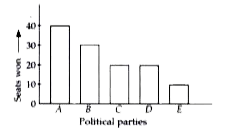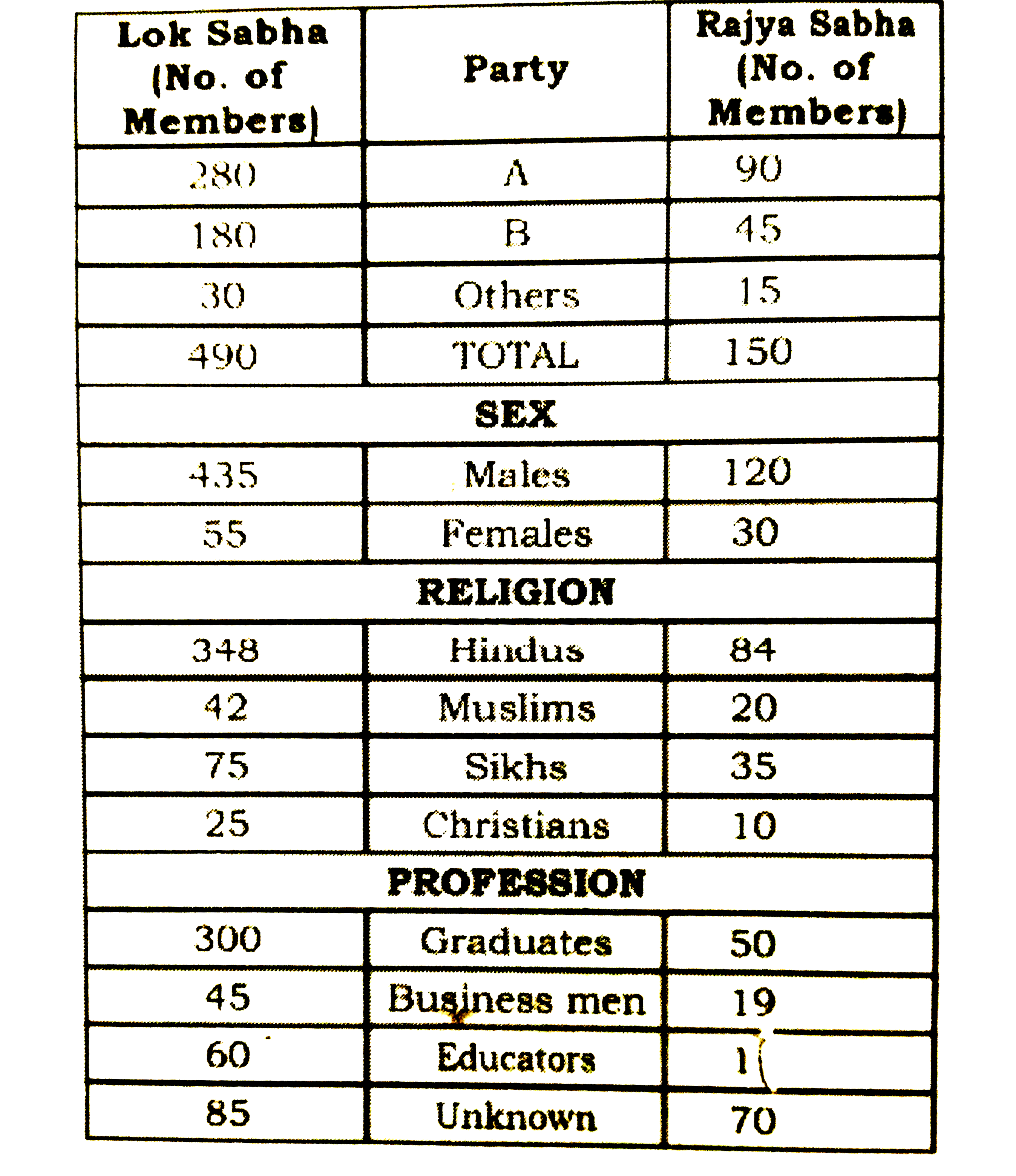There are five parties A, B, C, D and E in an election. Out of total 100000 votes cast, 36000 were cast to party A, 24000 to party B, 18000 to party C, 7000 to party D and rest to party E. What angle will be allocated for party E in the pie chart?
15∘
54∘
60∘
72∘
Step by step video & image solution for There are five parties A, B, C, D and E in an election. Out of total 100000 votes cast, 36000 were cast to party A, 24000 to party B, 18000 to party C, 7000 to party D and rest to party E. What angle will be allocated for party E in the pie chart? by Maths experts to help you in doubts & scoring excellent marks in Class 14 exams.
Updated on:21/07/2023Similar Questions
Observe the bar graph and answer the following questions.

What is the total number of seats won by party A and party B?
View SolutionIn a parliament election, a political party hired a public relations firm to promote its candidates in three ways telephone, house calls and letters. The cost per contact (in paise) is given in matrix A as A=[140200150]TelephoneHousecallLeers The number of contacts of each type made in two cities X and Y is given in the matrix B as B=[100050050003000100010000]CityXCityY Find the total amount spent by the party in the two cities. What should one consider before casting his/her vote partys promotional activity or their social activities ?
View Solution
Knowledge Check
In an election, a political party always tries to play a card so called 'Lower Caste'. What is lower caste being refers to?
AEqualityBPovertyCDalitDCommunitiesRead the given extract and answer the question that follows:
Democracies that follow a federal system all over the world tend to have two kinds of political parties: parties that are present in only one of the federal units and parties that are present in several or all units of the federation. This is the case in India as well. There are some countrywide parties, which are called National parties. These parties have their units in various states. But by and large, all these units follow the same policies, programmes and strategy that is decided at the National level. Every party in the country has to register with the Election Commission. While the Commission treats all parties equally, it offers some special facilities to large and established parties. These parties are given a unique symbol - only the official candidates of that party can use that election symbol. Parties that get this privilege and some other special facilities are 'recognised' by the Election Commission for this purpose. That is why these parties are called, 'Recognised Political Parties'. The Election Commission has laid down detailed criteria of the proportion of votes and seats that a party must get in order to be a recognised party. A party that secures at least six per cent of the total votes in an election to the Legislative Assembly of a State and wins at least Lok Sabha elections or Assembly elections in four States and wins at least four seats in the Lok Sabha two seats is recognised as a State party. A party that secures at least six per cent of the total votes in is recognised as a National Party.
Answer the following MCQ by choosing the most appropriate option:
A party is called 'National Party' only when it polls ____ of total valid votes in at least _____ states and in addition it wins ______ Lok Sabha Seats.A2%, Four, 4B6%, Four, 4C4%, Four, 4D2%, Four, 3Read the given extract and answer the question that follows:
Democracies that follow a federal system all over the world tend to have two kinds of political parties: parties that are present in only one of the federal units and parties that are present in several or all units of the federation. This is the case in India as well. There are some countrywide parties, which are called National parties. These parties have their units in various states. But by and large, all these units follow the same policies, programmes and strategy that is decided at the National level. Every party in the country has to register with the Election Commission. While the Commission treats all parties equally, it offers some special facilities to large and established parties. These parties are given a unique symbol - only the official candidates of that party can use that election symbol. Parties that get this privilege and some other special facilities are 'recognised' by the Election Commission for this purpose. That is why these parties are called, 'Recognised Political Parties'. The Election Commission has laid down detailed criteria of the proportion of votes and seats that a party must get in order to be a recognised party. A party that secures at least six per cent of the total votes in an election to the Legislative Assembly of a State and wins at least Lok Sabha elections or Assembly elections in four States and wins at least four seats in the Lok Sabha two seats is recognised as a State party. A party that secures at least six per cent of the total votes in is recognised as a National Party.
Answer the following MCQ by choosing the most appropriate option:
What does the Election Commission of India allot to all Parties so that they are called 'Recognised Political Parties'?AEmblemBMotifCSymbolDFlag

If all the others of Lok Sabha join the party B then what will be the ratio of the members of pary of A to be the members of pary B ?
View SolutionThe number of votes not cast for the Praja Party increased by 25% in the National General Election over those not cast for it in the previous Assembly polls and the Praja Party lost by a majority twice as large as that by which it had won the previous Assembly polls. If a total 2,60,000 people voted each time how many voted for the Praja Party in the previous Assembly polls? 110000 b. 120000 c. 140000 d. 150000
View SolutionRead the given extract and answer the question that follows:
Democracies that follow a federal system all over the world tend to have two kinds of political parties: parties that are present in only one of the federal units and parties that are present in several or all units of the federation. This is the case in India as well. There are some countrywide parties, which are called National parties. These parties have their units in various states. But by and large, all these units follow the same policies, programmes and strategy that is decided at the National level. Every party in the country has to register with the Election Commission. While the Commission treats all parties equally, it offers some special facilities to large and established parties. These parties are given a unique symbol - only the official candidates of that party can use that election symbol. Parties that get this privilege and some other special facilities are 'recognised' by the Election Commission for this purpose. That is why these parties are called, 'Recognised Political Parties'. The Election Commission has laid down detailed criteria of the proportion of votes and seats that a party must get in order to be a recognised party. A party that secures at least six per cent of the total votes in an election to the Legislative Assembly of a State and wins at least Lok Sabha elections or Assembly elections in four States and wins at least four seats in the Lok Sabha two seats is recognised as a State party. A party that secures at least six per cent of the total votes in is recognised as a National Party.
Answer the following MCQ by choosing the most appropriate option:
Every party in the country has to register with:
View SolutionRead the given extract and answer the question that follows:
Democracies that follow a federal system all over the world tend to have two kinds of political parties: parties that are present in only one of the federal units and parties that are present in several or all units of the federation. This is the case in India as well. There are some countrywide parties, which are called National parties. These parties have their units in various states. But by and large, all these units follow the same policies, programmes and strategy that is decided at the National level. Every party in the country has to register with the Election Commission. While the Commission treats all parties equally, it offers some special facilities to large and established parties. These parties are given a unique symbol - only the official candidates of that party can use that election symbol. Parties that get this privilege and some other special facilities are 'recognised' by the Election Commission for this purpose. That is why these parties are called, 'Recognised Political Parties'. The Election Commission has laid down detailed criteria of the proportion of votes and seats that a party must get in order to be a recognised party. A party that secures at least six per cent of the total votes in an election to the Legislative Assembly of a State and wins at least Lok Sabha elections or Assembly elections in four States and wins at least four seats in the Lok Sabha two seats is recognised as a State party. A party that secures at least six per cent of the total votes in is recognised as a National Party.
Answer the following MCQ by choosing the most appropriate option:
Two regional parties of West Bengal are:
View SolutionBy fulfilling which of the following conditions can a political party calim the status of a national party ?
1. It secures at least six per cen (6%) of the valid votes polled in any four or more states, at a general election to the House of the people or , to the State Legislative Assembly.
2. It wins at least fourt seats in the House of the People from any seats in House of the People (i.e., 11 seats in the existing House having 543 member), and these members are elected from at least three different States.
3. The party in question has got recognition as a state party in at least two states.
It must have its headquarters in New Delhi.
Select the correct answer using the code given below :
View Solution
